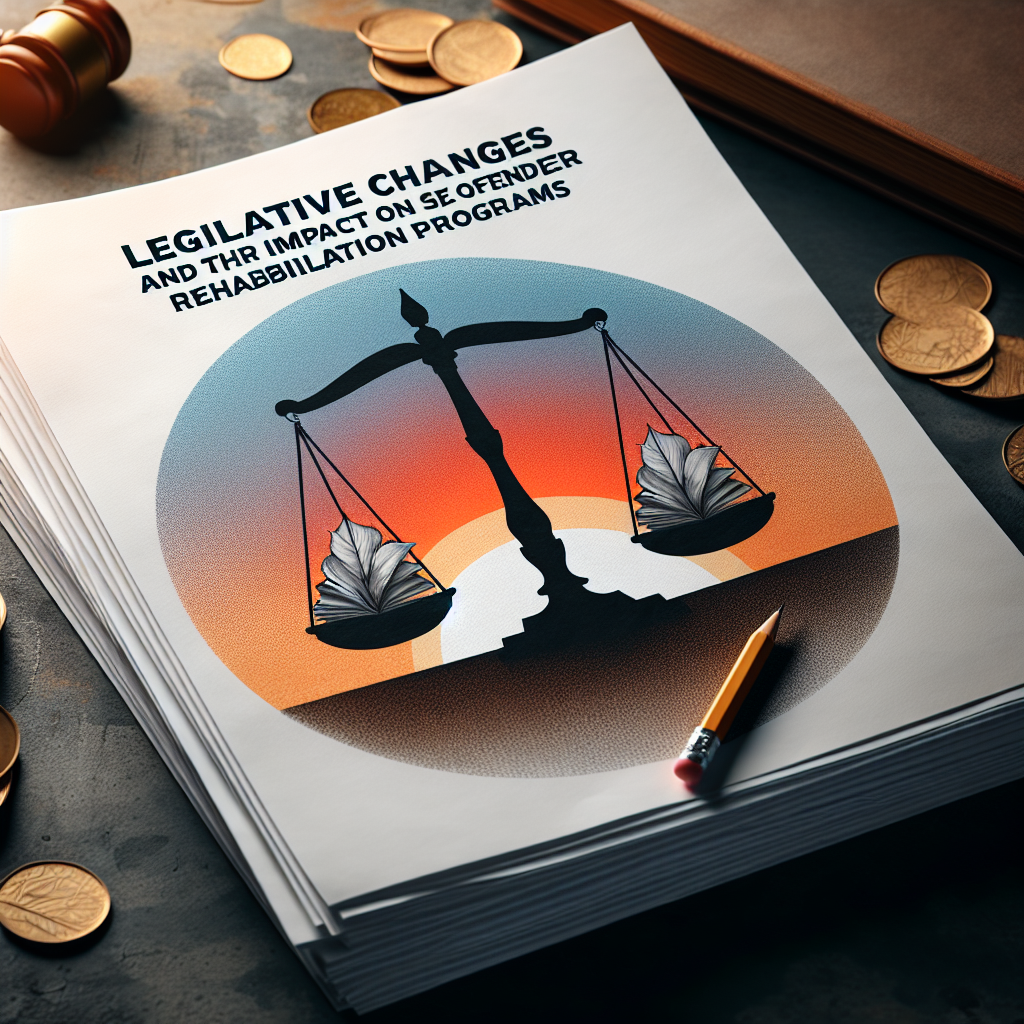
Introduction
In recent years, the landscape surrounding sex offender rehabilitation programs has undergone significant transformation. Legislative changes have sparked heated debates, stirring emotions and opinions within communities, policymakers, and mental health professionals alike. As society grapples with the complexities of rehabilitation versus punishment, understanding these legislative shifts and their implications is more crucial than ever.
This article delves into "Legislative Changes and Their Impact on Sex Offender Rehabilitation Programs," illuminating how recent laws shape the way we approach rehabilitation. From community safety to individual healing, we will explore both the positive and negative consequences of these legislative updates, offering unique insights and perspectives that can foster informed discussions on this pivotal issue.
The Legislative Landscape: An Overview
The Evolving Nature of Legislation
Over the past few decades, legislation concerning sex offenders has illustrated a swing toward public safety. More stringent laws have emerged, often inspired by high-profile cases, public outcry, or a particular political agenda. For example, legislation requiring sex offender registries or GPS tracking has become standard in many jurisdictions, highlighting societal demands for safety measures.
But while these laws aim at community protection, they also raise critical questions: How do these changes affect rehabilitation? Are they ultimately serving to facilitate healing and reintegration, or are they compounding a cycle of recidivism?
Key Legislative Changes
To understand "Legislative Changes and Their Impact on Sex Offender Rehabilitation Programs," we must examine specific legal shifts over recent years:
Megan’s Law (1996): A landmark piece of legislation that led to public sex offender registries in the United States. Intended to increase community safety, it nonetheless has prompted discussions about stigmatization and public shaming.
The Adam Walsh Act (2006): This act established a national sex offender registry and outlined stricter guidelines for classification of offenders. While it aimed to provide a uniform system to track sex offenders, its rigid classification has been criticized for undermining rehabilitative efforts.
California’s Proposition 57 (2016): Shifted focus from incarceration to rehabilitation for non-violent offenders, including many sex offenders. The goal was to improve access to treatment and reduce penalties, but implementation varied widely.
- The First Step Act (2018): Although primarily focused on federal prison reform, this legislation aimed to enhance rehabilitation programs, impacting the scope of treatment available to sex offenders in federal institutions.
Table 1: Overview of Key Legislative Changes in the U.S.
| Year | Legislation | Key Features | Rehabilitation Impact |
|---|---|---|---|
| 1996 | Megan’s Law | Public registries for sex offenders | Increased stigma, potential decrease in rehabilitation adherence |
| 2006 | Adam Walsh Act | National registry, stricter classifications | Limitations in tailored rehabilitation due to inflexible categorizations |
| 2016 | California’s Proposition 57 | Focus on rehabilitation for non-violent offenders | Improved access but variable implementation |
| 2018 | First Step Act | Enhancement of prison rehabilitation programs | Broader exposure to rehabilitative resources |
The Impact of Legislative Changes on Rehabilitation Programs
Stigmatization and Public Perception
Case Study: Megan’s Law
Megan’s Law exemplifies the consequences of legislative changes. While designed to protect communities, it has inadvertently stigmatized offenders, making it difficult for them to reintegrate into society post-treatment. Offenders may find themselves shunned by community members, leading to isolation, which can hamper rehabilitation efforts.
Analysis: The stigma linked to registries can deter offenders from seeking help, thereby increasing the risk of recidivism. Effective rehabilitation must take this societal perception into account, necessitating programs that incorporate community education and engagement.
Effectiveness of Rehabilitation Programs
Legislative frameworks can either enable or hinder the effectiveness of rehabilitation programs. The push for punitive measures often overshadows opportunities for recovery.
Case Study: California’s Proposition 57
An examination of California’s Proposition 57 reveals a multifaceted impact. On one hand, the shift towards rehabilitation decreased overcrowding in prisons; on the other hand, access to effective treatment varied significantly across facilities. Some regions embraced new rehabilitative measures, while others clung to traditional punitive approaches.
Analysis: This inconsistency illustrates a critical takeaway: effective rehabilitation requires not only supportive legislation but also the commitment of institutions to prioritize therapeutic programs. It showcases the direct correlation between the law’s intent and actual outcomes for offenders.
Recidivism Rates and Legislative Implications
Legislative changes directly influence recidivism rates among sex offenders. Stricter registration laws and treatment programs often lead to increased recidivism due to failure to address underlying issues.
Case Study: The Adam Walsh Act
The implementation of the Adam Walsh Act’s stringent regulations contributed to a spike in recidivism rates in several states. Offenders classified under restrictive categories faced increased behavioral issues due to lack of access to tailored rehabilitation services.
Analysis: By enforcing rigid classifications without addressing individual needs, the Act exemplifies how legislation can inadvertently undermine rehabilitation efforts. A focus on individual assessment and adaptable approaches may yield better outcomes.
Community Programs and Legislative Changes
Legislation tends to shape not just formal rehabilitation programs, but also community-led initiatives aimed at supporting former offenders. Positive legislative initiatives can drive funding and support for these grassroots programs.
Case Study: Federal Funding for Rehabilitation Programs
With the passage of the First Step Act, funding for rehabilitation initiatives surged. Programs that welcomed sex offenders back into the community blossomed, focusing on job training, therapy, and mentorship.
Analysis: Legislative support for community programs demonstrates how public policy can foster environments for reintegration and healing. These initiatives can serve as a model for future improvements in rehabilitation, emphasizing the importance of community involvement.
Best Practices in Navigating Legislative Changes for Rehabilitation
Navigating the landscape of "Legislative Changes and Their Impact on Sex Offender Rehabilitation Programs" necessitates adapting best practices within rehabilitation strategies:
Individualized Treatment Plans: Create tailored rehabilitation programs that account for individual offender backgrounds, mental health, and treatment histories to promote effective healing.
Community Engagement: Foster community dialogues that educate the public on the importance of rehabilitation, decrease stigma, and facilitate reintegration.
Policy Advocacy: Engage with policymakers to advocate for legislative reforms that prioritize rehabilitative needs over punitive measures, thereby promoting a more balanced approach.
- Program Evaluation: Implement regular assessments of existing programs to identify strengths and weaknesses, ensuring they meet the evolving needs of offenders effectively.
Conclusion
The intricate web of "Legislative Changes and Their Impact on Sex Offender Rehabilitation Programs" reveals a complex interplay between policy, community safety, and individual healing. While legislative shifts may aim to create safer environments, they must not overshadow the critical need for rehabilitation and support for offenders aiming to reintegrate into society.
Approaching these legislative changes with informed strategies rooted in community collaboration and individualized treatment can pave the way for more effective rehabilitation. As society continues to evolve, the imperative remains clear: effective rehabilitation is not just a legal obligation but a moral one, significant for both the offenders and the communities in which they live.
FAQs
1. What are sex offender rehabilitation programs?
Sex offender rehabilitation programs are therapeutic interventions designed to address the underlying issues that contribute to sexual offending behavior. They often include therapy, education, and support services aimed at reintegration into society.
2. How do legislative changes affect these programs?
Legislative changes can impact funding, eligibility for programs, and the overall approach to rehabilitation versus punishment. Stricter laws may hinder access to effective treatment.
3. Are there successful rehabilitation models for sex offenders?
Yes, many programs have shown success by focusing on individualized treatment plans, including cognitive-behavioral therapy, support groups, and community engagement initiatives.
4. How can stigma against sex offenders be reduced?
Education and awareness campaigns can help demystify sex offending behaviors, encouraging supportive community interactions that foster rehabilitation opportunities.
5. What role can communities play in the rehabilitation of sex offenders?
Communities can provide social support, employment opportunities, and educational resources, creating a welcoming environment that encourages positive change and reduces recidivism.
As the conversation around sexual offender rehabilitation continues to evolve, it’s crucial that stakeholders work together to navigate the complex landscape formed by legislative changes and their direct impact on rehabilitation outcomes.

















